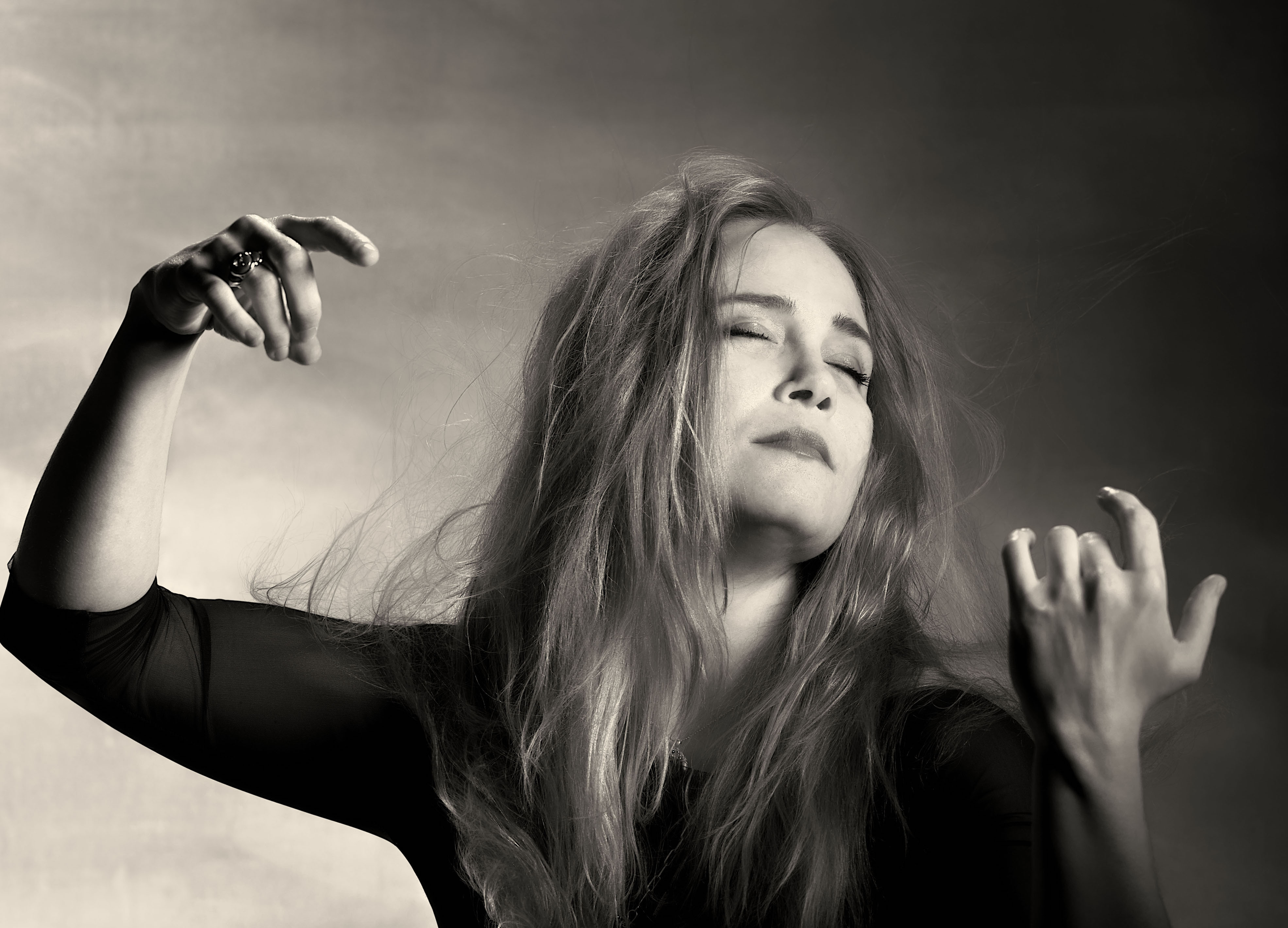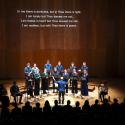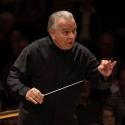At first glance, this looked like an odd coupling: Stravinsky’s Violin Concerto from 1931, all spiky neo-classicism and short-winded expressionist sparkle, as a tributary opening before the mighty rolling stream of Bruckner’s Seventh Symphony.
Yet in the accomplished hands of Paavo Järvi and the London Philharmonic Orchestra, with Leila Josefowicz as the soloist, these strange bedfellows turned out to make perfectly perfectly good sense. Stravinsky’s analytic relish in breaking the grammar of the classical concerto down into glittering, even competing, blocks of sound prepared us for the Bruckner who glories in contrasts and code-switches, a visionary who glimpsed the overarching unity within potentially jarring musical contradictions. Järvi’s Bruckner scarcely has an equal today (listen to his superlative recordings with the Zürich Tonhalle orchestra) and this Seventh might, in the composer’s bicentenary year, have begun to melt the most stubborn sceptic’s heart.
Josefowicz (pictured below by Tom Zimberoff), who had long made a speciality of the Stravinsky, sounded unafraid of offering a harsh, even rugged, welcome as the opening Toccata flung its core motif against the LPO’s splendidly imposing low brass (and we would be hearing plenty more from them). The violin’s grainy, even rasping, tone lent a cabaret throatiness, and smokiness, to these jazz-age excursions around an antique form. The LPO various sections became tight, distinct groups in tetchy dialogue with a capricious solo voice. In the absence of big conventional tutti, Järvi’s crisp direction held the show together and drew a firm frame for Josefowicz’s more lyrical flights in the two middle-movement “arias”.  Especially in the second aria, the surprise return of a lyrical, vibrato-fuelled warmth and an almost Bachian serenity felt, under this player’s bow, like a true homecoming, not simply an ironic quotation or pastiche. Then the skittish brilliance of the closing Capriccio jolted us awake from this fugitive dream of a vanished harmonic order. Josefowicz’s timbres and textures balanced the abrasive and emollient sides of Stravinsky’s score, while Järvi’s drive and poise made the orchestra’s disparate conversations with the violin cohere. The soloist brought bags of bravura, dramatic charm to the Capriccio – even though this is charm that never sheds its edge of danger, even of panic.
Especially in the second aria, the surprise return of a lyrical, vibrato-fuelled warmth and an almost Bachian serenity felt, under this player’s bow, like a true homecoming, not simply an ironic quotation or pastiche. Then the skittish brilliance of the closing Capriccio jolted us awake from this fugitive dream of a vanished harmonic order. Josefowicz’s timbres and textures balanced the abrasive and emollient sides of Stravinsky’s score, while Järvi’s drive and poise made the orchestra’s disparate conversations with the violin cohere. The soloist brought bags of bravura, dramatic charm to the Capriccio – even though this is charm that never sheds its edge of danger, even of panic.
With our ears primed by Stravinsky, after the interval we heard Järvi make Bruckner sound simultaneously modern and ancient; earthbound but airborne too. If you dread ponderous heaviness and stultifying monumentality in the Austrian’s vast tapestries of symphonic sound, here is the conductor to assuage your fears. For a start, he doesn’t drag or linger as some of the classic interpreters do: 64 minutes for the Seventh versus 70-plus under some august batons. And the LPO, led by the ever-estimable Pieter Schoeman, has such strength-in-depth of character and voice across its individual sections that we never felt in danger of drowning in some blurry wave of sound. In the outer movements especially, Järvi swung and bounced with a litheness and nimbleness that recalled not just Schubert but (weirdly, and maybe only to my ears) Dvořák. Bruckner the countryman, rather than the mystic, never stood far away.
The great cello theme (kudos to Kristina Blaumane and her colleagues) ushered in an Allegro moderato packed with vernal freshness and a lilting grace. Horns (led by John Ryan) and trombones (Mark Templeton) glowed and blazed, while Juliette Bausor’s flute eloquently spoke – here and throughout the symphony – for a tender intimacy in the midst of crashing change. True, Järvi – a fine craftsman of crescendos – built the big climaxes into steepling surfers’ waves of oceanic feeling, but they never flooded the mood of the whole work. If you want wall-to-wall rapture from your Bruckner, you may need to apply elsewhere. Järvi can soar, but he can dance too.
In the stupendous Adagio, supposedly prompted by the passing of Wagner, the serene string chorale counted for as much as the famous eruption of a quartet of Wagner “tubas” (joined by Lee Tsarmaklis’s standard tuba) at the start. The LPO brass does pack a wonderful punch, but this was not an evening for heavy-metal fetishists. Järvi paced, and paused, with finesse, and allowed us to hear the strength and subtlety of other instrumental voices – not least, the admirable battery of basses led by Kevin Rundell. Given the “sehr feierlich” marking, ardent Brucknerites might have expected more funereal grandeur, but solemnity can (as here) be restrained and melodrama-free. Järvi used the Nowak edition of the symphony, with added percussion, but it never dominated. The note of mourning struck by the lovely LPO strings felt fragile, and wistful, rather than thumpingly heroic: notoriously, in 1945 German radio prefaced the announcement of Hitler’s death with this movement. You wonder what its listeners really thought. A hard-driving scherzo thrillingly put Paul Beniston and the trumpets in the spotlight, but Järvi (pictured above by Kaupo Kikkas) carefully managed the shifts of gear and dynamic variations kept rhythmic monotony at bay. The gentle, even rustic, swing of the Trio in the strings claimed an equal value here with the fateful drama of the hefty brass. Järvi’s Bruckner lifts the heart but (unlike some grandiose versions) it never tries to twist your arm. The transcendence is for us to find, if we can.
A hard-driving scherzo thrillingly put Paul Beniston and the trumpets in the spotlight, but Järvi (pictured above by Kaupo Kikkas) carefully managed the shifts of gear and dynamic variations kept rhythmic monotony at bay. The gentle, even rustic, swing of the Trio in the strings claimed an equal value here with the fateful drama of the hefty brass. Järvi’s Bruckner lifts the heart but (unlike some grandiose versions) it never tries to twist your arm. The transcendence is for us to find, if we can.
In keeping with his overall approach, Järvi brought the finale to life with a disarmingly light touch, without making its themes sound in any sense lightweight. The woods resumed their vein of refined tenderness, horns and lower brass returned with a golden warmth, while the pizzicato basses rocked us compellingly towards home. Transparent textures and bright colours from all corners of the LPO meant that this Seventh never bored – but neither did it cow us into crushed reverence. Järvi doesn’t diminish Bruckner. He does restore the outsize eccentric genius – or monster – to an attractively human scale.














Add comment